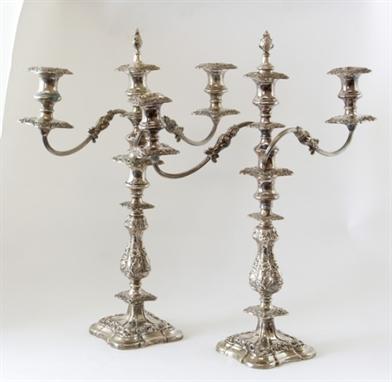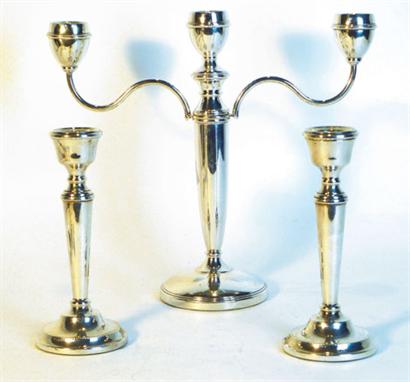We found 29920 price guide item(s) matching your search
There are 29920 lots that match your search criteria. Subscribe now to get instant access to the full price guide service.
Click here to subscribe- List
- Grid
-
29920 item(s)/page
Bridgens Furniture with Candelabra 1838 hand-coloured engraved title and 59 plates on 58 sheets 1 double-page 2 plates (including double-page) with repaired tear through image the single plate across whole image contemporary morocco-backed cloth rebacked preserving original backstrip corners worn cloth soiled folio William Pickering 1838.
A pair of Continental gilt bronze and porcelain mounted twin light candelabra, second half 19th century, each with foliate clad sockets and conforming drip pans on serpentine branches with porcelain flowers and entwining foliate sprigs, rising from either side of an openwork arbour, with two cavorting amorini within, 22.5cm high, 35.5cm wide
A pair of Continental gilt bronze and mirror glass mounted twin light candelabra in the Louis XIV taste, late 19th century, each with foliate cast sockets and drip pans on foliate cast branches rising from an openwork frame, above oval bases inset with mirror platforms, on scrolling, foliate cast feet, 22cm high excluding electrical fitments; and a pair of cut glass hung metal twin light candelabra, 20th century, 33cm high
A pair of Italian carved, polychrome painted and parcel giltwood Blackamoor standard candelabra, early 20th century, modelled opposing, each with six sockets on scrolling branches issuing from an urn, the Moors portrayed standing on porphyry blocks, 125cm high excluding electrical fitments, (possibly lacking bases)
A pair of Italian carved, polychrome painted and parcel giltwood Blackamoor standard candelabra, early 20th century, modelled opposing, each with six sockets on scrolling branches issuing from an urn, the Moors portrayed standing on porphyry blocks, 125cm high excluding electrical fitments, (possibly lacking bases)
A French belge noir and veined red marble drum head mantel clock, late 19th century, the eight-day bell striking movement with circular white enamel Roman numeral dial in a cylindrical red marble drum supported via carved scrolls on a plinth base incorporating shaped apron, 29cm high; with a pair of gilt metal five light candelabra each with upright cast in the Art Nouveau style and on stepped red marble base, 47cm high.
A PARCEL-GILT-SILVER CANDELABRUM, STUART DEVLIN, LONDON, 1968 three trumpet form supports of differing heights joined by a textured stretcher and supporting irregularly soldered gilt wirework spherical shades 42cm high, 1248gr (40oz) including small wood feet The Pearson Silver Collection has a pair of candelabra of this pattern and date, see: www.pearsonsilvercollection.com/devlin
A massive and rare pair of Chinese bronze ornamental sculptures, in Venetian style based on candelabra or andirons. Each cast with male and female satyrs surmounted by urns decorated with four winged herms, the triform bases heavily cast with baroque scrolls and each with oval cartouches, three inscribed with two Chinese characters `ge deng`, c.1860s, 76cm. (2) `Ge-Deng` is the personalised name for Gordon in Chinese, and also relates to the Gordon Clan heraldic device, where `ge` means spear or lance and `deng`, to mount or enter. Cf. Oriental Art, Spring 1988, Vol XXXIV No.1, pp.4-19 where Dr Eldon E Worrall argues a strong case that the bronzes originate in Southern China, c.1860s, probably in Canton or Macao, and as a gift to General Gordon from an Oriental rather than a European. The evidence for this relies on a combination of factors, including the examination of stylistic and technical details, chemical analysis, and the link to China through Nils Anderson-Westergren. A number of Chinese objects, including Gordon`s seal, have identical calligraphy and are now housed in the Royal Engineers Museum at Brompton Barracks, Chatham, Kent. Provenance: discovered inside a dumb waiter in the house of a Liverpool merchant and formerly in store at a shop premises in Park Road, Liverpool where they were owned by the grandson of Nils Anderson-Westergren, (a seaman believed to be in China just prior to 1864). Previously on loan and exhibited at the National Museums and Galleries on Merseyside, (formerly Liverpool Museum). Charles Gordon (Chinese Gordon) General Charles George Gordon died at the siege to Khartoum in 1885. Previously he served in China, arriving at Tianjin in 1860; he was present at the occupation of Beijing and the destruction of the Summer Palace. The British forces occupied northern China until April 1862, then under General William Staveley, withdrew to Shanghai to protect the European settlement from the rebel Taiping army. In 1863, he took command of the `Ever Victorious Army`. Later, the Emperor promoted Gordon to the rank of titu, meaning: `Chief commander of one province`s military`, one of the highest grades in the Chinese army, and decorated him with the Yellow Jacket, and raised him Qing`s Viscount of second class. The British Army promoted Gordon to Lieutenant-Colonel and he was made a Companion of the Bath. He also gained the popular nickname `Chinese Gordon`.
A late 19th Century slate, marble and spelter clock garniture, the clock with eight day movement striking on a bell, the circular dial with Arabic numerals and inscribed `A. Bagarry, Lorgues`, the rectangular case surmounted with a man holding the reins of a rearing horse above scroll handles, on scroll feet, together with a pair of matching five light scroll branch candelabra, with a key.
A pair of 20th century Continental two light table candelabra in antique style with figures, flowers and scrolling, a German 20th century table decoration in the form of a flower encrusted two handled urn with two attendant naked cherubs on a flower strewn rococo plinth and two Continental posy holders in the form of swan like sledges with attendant cherubs (all as viewed).
-
29920 item(s)/page















































